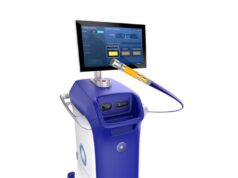
Initial real-world experience with the S-ICD (subcutaneous implantable cardioverter defibrillator) in the USA show that implant success rate is high and short-term complications acceptably low.
Michael R Gold, of the Medical University of South Carolina, Charleston, USA, presented the findings at a late-breaking clinical trial session at the Heart Rhythm Society’s 38th Annual Scientific Sessions (10‒13 May, Chicago, USA).
He said: “Overall, we were very pleased with these results, which show that despite broadening the group implanted to a sicker population, and despite increasing the number of centres beyond just very experienced implanters—we got very encouraging and very good short-term results. And the follow-up is planned for five years, so we will be able to use this cohort to understand long-term functioning of this device.”
S-ICDs were developed to reduce complications associated with transvenous ICD leads.
Gold told delegates: “This is a unique device in many ways, not just because of the absence of transvenous leads. It has minimal pacing functionality, with only transient post-shock transthoracic pacing. This aspect of the device and its novelty has led to previous studies largely enrolling niche populations of patients with normal or near normal LV function, and a few comorbidities.”
These differences between subcutaneous and transvenous ICD trial participants made comparisons between systems difficult. The S-ICD post-market approval study was designed to evaluate a more real-world US population. Following approval in 2013, a prospective registry was undertaken. Participants were prospectively enrolled if they met the criteria for an ICD or were currently implanted with an S-ICD from the IDE study, and had passed a screening vector test. Patients with a life expectancy <1 year were excluded. Only patients with newly implanted S-ICDs were included in this analysis, although patients previously implanted with S-ICDs are included in the registry.
Gold said: “The study included over 1600 patients at 86 centres, which is almost four times as large as the next largest study ever of this device. This is a much more typical population of patients, similar to those that receive transvenous defibrillators, than the population previously evaluated for S-ICDs. Two-thirds of patients were primary prevention patients with a low EF [ejection fraction], which is the most common indication for ICDs in the USA. About three-quarters had heart failure, more than 60% had hypertension, and a third had diabetes. And importantly, over 13% of patients were on dialysis. Despite this sicker patient cohort, acute success was high. The conversion of inducible VT/VF [ventricular fibrillation/ventricular tachycardia] was successful in 98.7% of patients, and freedom from complications peri-operatively was 96.2%. These data suggest that inclusion of patients with broader comorbidities across more implanting centres will not adversely impact short-term complication rates associated with the device.”
Mean age was 53.2 years, 68.6% were male, 28% were African American, and the average body mass index was 29.8. Electrocardiogram screening was successful in at least one, two, or three vectors in 100%, 93.8%, and 51.4%, respectively. Multivariate analysis revealed no clinical predictors of the number of vectors passed. Implantation was with a 2-Incision technique in 52.2%, of patients and under general anaesthetic in 64.1%. Repositioning occurred in 2.8% of patients during initial implant, and in 0.7% in 30-day follow-up. Predictors of complications with the device were a younger age, a higher body mass index, and diabetes, consistent with predictions of many other studies.
Gold concluded: “The results were very encouraging. At this point we only have the 30-day data. The exciting part is that it will have quite good follow-up on a broad population of patients, so we will get very accurate data. It will be the most up-to date platform of this device.”








